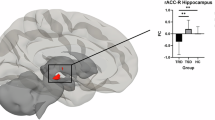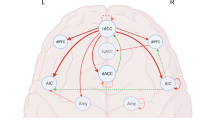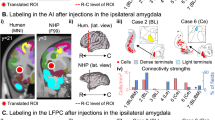Abstract
Habituation of the neural response to repeated stimuli has been well demonstrated for subcortical limbic regions responding to emotionally salient stimuli. Although the rostral or affective division of the anterior cingulate cortex (rACC) is also engaged during emotional processing, little is known about the temporal dynamics of this region in sustained evaluation of emotional salience. Using a test/retest design, the present study assessed habituation in the human brain with functional magnetic resonance imaging. Eight healthy subjects were exposed to two repeated runs of aversive, neutral, and blank images. Activation of the rACC to negatively valenced pictures occurred only in the first session, and this activation was significantly greater in the first relative to the second session. Additionally, medial prefrontal cortex, hippocampal, and amygdalar activations were noted during the first, but not second, presentation of aversive pictures. These findings highlight the phasic activity of the rACC in emotional processing consistent with habituation.
Similar content being viewed by others
Log in or create a free account to read this content
Gain free access to this article, as well as selected content from this journal and more on nature.com
or
References
Aston-Jones G, Rajkowski J, Kubiak P, Valentino RJ, Shipley MT (1996). Role of the locus coeruleus in emotional activation. Prog Brain Res 107: 379–402.
Breiter HC, Etcoff NL, Whalen PJ, Kennedy WA, Rauch SL, Buckner RL et al (1996). Response and habituation of the human amygdala during visual processing of facial expression. Neuron 17: 875–887.
Bush G, Luu P, Posner MI (2000). Cognitive and emotional influences in anterior cingulate cortex. Trends Cogn Sci 4: 215–222.
Canli T, Zhao Z, Desmond JE, Kang E, Gross J, Gabrieli JD (2001). An fMRI study of personality influences on brain reactivity to emotional stimuli. Behav Neurosci 115: 33–42.
Critchley HD, Elliott R, Mathias CJ, Dolan RJ (2000). Neural activity relating to generation and representation of galvanic skin conductance responses: a functional magnetic resonance imaging study. J Neurosci 20: 3033–3040.
Critchley HD, Mathias CJ, Dolan RJ (2001). Neural activity in the human brain relating to uncertainty and arousal during anticipation. Neuron 29: 537–545.
Critchley HD, Melmed RN, Featherstone E, Mathias CJ, Dolan RJ (2002). Volitional control of autonomic arousal: a functional magnetic resonance study. Neuroimage 16: 909–919.
Devinsky O, Morrell MJ, Vogt BA (1995). Contributions of anterior cingulate cortex to behaviour. Brain 118(Pt 1): 279–306.
Drevets W, Raichle M (1998). Reciprocal suppression of regional cerebral blood flow during emotion versus higher cognitive processes: implication for interactions between emotion and cognition. Cogn Emotion 12: 353–385.
Feinstein JS, Goldin PR, Stein MB, Brown GG, Paulus MP (2002). Habituation of attentional networks during emotion processing. Neuroreport 13: 1255–1258.
Fischer H, Furmark T, Wik G, Fredrikson M (2000). Brain representation of habituation to repeated complex visual stimulation studied with PET. Neuroreport 11: 123–126.
Friston KJ, Holmes AP, Poline JB, Grasby PJ, Williams SC, Frackowiak RS, Turner R (1995). Analysis of fMRI time-series revisited. Neuroimage 2: 45–53.
Hamann S, Mao H (2002). Positive and negative emotional verbal stimuli elicit activity in the left amygdala. Neuroreport 13: 15–19.
Hariri AR, Tessitore A, Mattay VS, Fera F, Weinberger DR (2002). The amygdala response to emotional stimuli: a comparison of faces and scenes. Neuroimage 17: 317–323.
Holland PC, Gallagher M (1999). Amygdala circuitry in attentional and representational processes. Trends Cogn Sci 3: 65–73.
Holmes A, Friston KJ (1998). Generalizability, random effects, and population inference. Neuroimage 7: S754.
Irwin W, Davidson RJ, Lowe MJ, Mock BJ, Sorenson JA, Turski PA (1996). Human amygdala activation detected with echo-planar functional magnetic resonance imaging. Neuroreport 7: 1765–1769.
Lane RD, Chua PM, Dolan RJ (1999). Common effects of emotional valence, arousal and attention on neural activation during visual processing of pictures. Neuropsychologia 37: 989–997.
Lane RD, Fink GR, Chau PM, Dolan RJ (1997). Neural activation during selective attention to subjective emotional responses. Neuroreport 8: 3969–3972.
Lane RD, Reiman EM, Axelrod B, Yun LS, Holmes A, Schwartz GE (1998). Neural correlates of levels of emotional awareness. Evidence of an interaction between emotion and attention in the anterior cingulate cortex. J Cogn Neurosci 10: 525–535.
Lang PJ, Bradley MM, Cuthbert BN (1997). International Affective Picture System (Hariri et al): Technical Manaual and Affective Ratings. Gainesville, FL: NIMH Center for the Study of Emotion and Attention, University of Florida.
Lang PJ, Bradley MM, Cuthbert BN (1998). Emotion, motivation, and anxiety: brain mechanisms and psychophysiology. Biol Psychiatry 44: 1248–1263.
LeDoux JE (2000). Emotion circuits in the brain. Annu Rev Neurosci 23: 155–184.
Liberzon I, Zubieta JK, Fig LM, Phan KL, Koeppe RA, Taylor SF (2002). mu-Opioid receptors and limbic responses to aversive emotional stimuli. Proc Natl Acad Sci USA 99: 7084–7089.
Mayberg HS (1997). Limbic-cortical dysregulation: a proposed model of depression. J Neuropsychiatry Clin Neurosci 9: 471–481.
Morgan MA, LeDoux JE (1999). Contribution of ventrolateral prefrontal cortex to the acquisition and extinction of conditioned fear in rats. Neurobiol Learn Mem 72: 244–251.
Niedenthal PM, Kitayama S (1994). The Heart's Eye-Emotional Influences in Perception and Attention. Academic Press: New York.
Oppenheim AV, Schafer RW (1989). Discrete-Time Signal Processing. Prentice–Hall: Englewood Cliffs, NJ.
Phan KL, Taylor SF, Decker LR, Welsh RC, Noll DC, Nichols TE et al (2001). Detecting amygdala activations for aversive pictures with fMRI using 2-shot acquisition. Annual Meeting of the American College of Neuropsychopharmacology Scientific Abstracts, pp 228.
Phan KL, Taylor SF, Welsh RC, Decker LR, Noll DC, Nichols TE et al (2003). Activation of the medial prefrontal cortex and extended amygdala by individual ratings of emotional arousal: a functional magnetic resonance imaging study. Biol Psychiatry 53: 211–215.
Phan KL, Wager T, Taylor SF, Liberzon I (2002). Functional neuroanatomy of emotion: a meta-analysis of emotion activation studies in PET and fMRI. Neuroimage 16: 331–348.
Poline JB, Worsley KJ, Holmes AP, Frackowiak RS, Friston KJ (1995). Estimating smoothness in statistical parametric maps: variability of p values. J Comput Assist Tomogr 19: 788–796.
Siddle DA (1991). Orienting, habituation, and resource allocation: an associative analysis. Psychophysiology 28: 245–259.
Sokolov E (1963). Perception and the Conditioned Reflex. Pergamon Press: Oxford.
Stenger VA, Boada FE, Noll DC (2002). Multishot 3D slice-select tailored RF pulses for MRI. Magn Reson Med 48: 157–165.
Taylor SF, Liberzon I, Koeppe RA (2000). The effect of graded aversive stimuli on limbic and visual activation. Neuropsychologia 38: 1415–1425.
Taylor SF, Phan KL, Decker LR, Liberzon I (2003). Subjective rating of emotionally salient stimuli modulates neural activity. Neuroimage 18: 650–659.
Thompson RF, Spencer WA (1966). Habituation: a model phenomenon for the study of neuronal substrates of behavior. Psychol Rev 73: 16–43.
Vogt BA, Finch DM, Olson CR (1992). Functional heterogeneity in cingulate cortex: the anterior executive and posterior evaluative regions. Cereb Cortex 2: 435–443.
Whalen PJ, Bush G, McNally RJ, Wilhelm S, McInerney SC, Jenike MA et al (1998a). The emotional counting Stroop paradigm: a functional magnetic resonance imaging probe of the anterior cingulate affective division. Biol Psychiatry 44: 1219–1228.
Whalen PJ, Rauch SL, Etcoff NL, McInerney SC, Lee MB, Jenike MA (1998b). Masked presentations of emotional facial expressions modulate amygdala activity without explicit knowledge. J Neurosci 18: 411–418.
Winston JS, Strange BA, O'Doherty J, Dolan RJ (2002). Automatic and intentional brain responses during evaluation of trustworthiness of faces. Nat Neurosci 5: 277–283.
Woods RP, Grafton ST, Holmes CJ, Cherry SR, Mazziotta JC (1998). Automated image registration: I. General methods and intrasubject, intramodality validation. J Comput Assist Tomogr 22: 139–152.
Wright CI, Fischer H, Whalen PJ, McInerney SC, Shin LM, Rauch SL (2001). Differential prefrontal cortex and amygdala habituation to repeatedly presented emotional stimuli. Neuroreport 12: 379–383.
Acknowledgements
We thank Thomas Nichols, Douglas Noll, Laura Decker, Samir Khan, and Keith Sudheimer for their assistance in this study. This research was supported in part by the APIRE/Janssen Fellowship (KLP), NIMH K08 MH01258 (SFT), the Ann Arbor Veterans Administration Medical Center (IL), and the University of Michigan fMRI Laboratory.
Author information
Authors and Affiliations
Corresponding author
Rights and permissions
About this article
Cite this article
Luan Phan, K., Liberzon, I., Welsh, R. et al. Habituation of Rostral Anterior Cingulate Cortex to Repeated Emotionally Salient Pictures. Neuropsychopharmacol 28, 1344–1350 (2003). https://doi.org/10.1038/sj.npp.1300186
Received:
Revised:
Accepted:
Published:
Issue date:
DOI: https://doi.org/10.1038/sj.npp.1300186
Keywords
This article is cited by
-
Temporally dynamic neural correlates of drug cue reactivity, response inhibition, and methamphetamine-related response inhibition in people with methamphetamine use disorder
Scientific Reports (2022)
-
Common brain activations for painful and non-painful aversive stimuli
BMC Neuroscience (2012)
-
Relative Effectiveness of Emotion Induction Procedures and the Role of Personal Relevance in a Clinical Sample: A Comparison of Film, Images, and Music
Journal of Psychopathology and Behavioral Assessment (2012)
-
Regret and its avoidance: a neuroimaging study of choice behavior
Nature Neuroscience (2005)



